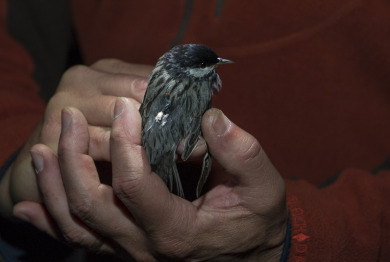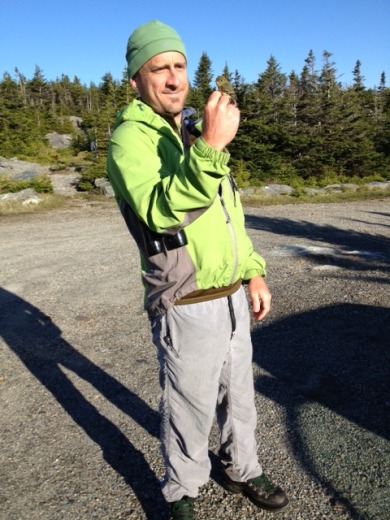VCE’s first 2014 foray to our long-term study site on the Mt. Mansfield ridgeline made some history. This marks our 23rd consecutive year of monitoring the breeding birds there. We were all eager, and a bit anxious, to know whether any of the 19 Blackpoll Warblers fitted with light-level geolocators last summer had returned, and would yield the precious information contained in their miniature backpacks.
Weather was cool, dry and calm as Steve Faccio, John Lloyd and I we set up 19 mist nets on Wednesday evening. We immediately caught a slug of unbanded Swainson’s Thrushes (SWTH), which appear to have been creeping upslope over the past 2-3 years. Our first Bicknell’s Thrush (BITH) was a male we had banded as a yearling last June. This was followed by another male with a very worn band, which our records show had been placed on 12 June 2007, when the bird was then at least 2 years old, meaning it was hatched in 2005 or earlier! Although falling short of a new longevity record for the species (that distinction belongs to an 11 year-old male from Stratton Mountain), this was the third 10 year-old bird we’ve documented on Mansfield. Although this individual has undoubtedly been present on the ridgeline in every summer since our original 2007 capture, we’d mist-netted it only a total of 6 times previously: twice in 2007, once in each of 2008, 2010, 2011 and 2012.
As dusk was descending, we hit Blackpoll pay dirt, with the Amherst Trail recapture of #2110-80395, still sporting his 0.5-gram geolocator and looking none the worse for wear! Even more remarkable, this is one of the oldest Blackpolls on record – we banded him on 24 June 2009, and he’s now > 6 years old. We’ve caught him in every summer since, including 5 times last year. We dutifully removed his geolocator (wondering whether he sighed in relief or would miss his studly adornment), and we’ll download the data inside soon. Whatever we learn about where the bird overwintered, what route(s) he followed, when he departed, and how long he spent in transit, it is nothing short of astonishing that this 11-gram bird has successfully negotiated round-trip flights between Mansfield and northern South America at least 6 times!
While we didn’t recapture any other geolocatored Blackpolls before wrapping up at noon the following day, Steve Faccio was quite certain he saw a banded bird with a small stalk protruding above its back feathers. We’ll be back on the mountain weekly through late July, so we’re very hopeful of additional recoveries.
Overall, we mist-netted 46 individuals of 8 species. These included 9 BITH (4 new, 5 returns from previous years), 7 SWTH (6 new, 1 return), 3 American Robins (2 new, 1 return female from 2013), 10 Yellow-rumped Warblers (9 new, 1 return male from 2013), 6 Blackpolls (3 new males, 2 new females, and our returning hero), 7 White-throated Sparrows (4 new, 3 returns including a male from 2009), 2 new Yellow-belled Flycatchers (another species that may be moving upslope), and a single Black-capped Chickadee.
Outside the nets, our ridgeline bird list was a respectable 18 species. The biggest surprise by far was an energetically singing towhee, the first we’ve ever had up there in 23 years!
Turkey Vulture 1
Chimney Swift 1
Yellow-bellied Flycatcher 2 singing
Blue-headed Vireo 1 singing
Blue Jay 2
Common Raven 1
Red-breasted Nuthatch 1
Winter Wren 2 singing
Bicknell’s Thrush 15 singing and calling
Swainson’s Thrush 4
American Robin 6 (3 pairs; 2 nests found)
Magnolia Warbler 1
Blackpoll Warbler 15 singing
Yellow-rumped Warbler (Myrtle) 10 (8 singing males)
Eastern Towhee 1 singing male moving about on ridgeline for 30 minutes
White-throated Sparrow 7 singing
Dark-eyed Junco (Slate-colored) 6 (4 singing males)
Purple Finch 1 singing



Hi Chris, looks like a very productive trip. Nice write up here. Thanks!
Ted
‘very exciting! ‘Most interested in learning the story from the BLPW geolocator!
thank you..i received a lot of information about many destination from your website..keep writing and may god bless u